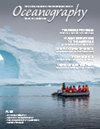佛罗里达群岛国家海洋保护区禁渔区内外的珊瑚礁鱼类丰度、生物量和生物多样性:1999-2008
IF 2.8
4区 地球科学
Q1 OCEANOGRAPHY
引用次数: 1
摘要
1999年至2018年间,佛罗里达群岛国家海洋保护区(FKNMS)珊瑚礁视觉普查项目的观测结果被用作美国海洋生物多样性观测网络的案例研究,以评估不同栖息地类型的地区是否存在生物多样性指标(丰度、生物量、丰富度、辛普森多样性和功能多样性)的差异(高起伏、线性和斑块珊瑚礁)、保护级别(禁捕区和无保护区)和保护区类型。在观察期开始时,保护区的珊瑚鱼生物量高于未保护区,但这些指标随着时间的推移而下降。我们没有发现禁捕海域大小的影响,而是发现大面积(18.7平方公里)和小面积(平均0.85平方公里)的珊瑚礁鱼类丰度、生物量和多样性指数相似。高起伏礁栖息地的礁鱼丰度(20%-30%)和物种丰富度(~20%)最高,生物量几乎是其他栖息地地层的两倍,但2007年后,线性和斑块礁的生物量下降了20%-30%。尽管高起伏珊瑚礁对生物多样性保护和恢复很重要,但政策应解决整个FKNMS中观察到的鱼类丰度、生物量和多样性的下降问题。应持续进行监测,以支持政策并应对与气候变化和资源使用有关的不断变化的条件。本文章由计算机程序翻译,如有差异,请以英文原文为准。
Reef-Fish Abundance, Biomass, and Biodiversity Inside and Outside No-Take Marine Zones in the Florida Keys National Marine Sanctuary: 1999–2018
Observations from the Reef Visual Census program in the Florida Keys National Marine Sanctuary (FKNMS) between 1999 and 2018 were used as a US Marine Biodiversity Observation Network case study to assess whether differences in biodiversity metrics (abundance, biomass, richness, Simpson diversity, and functional diversity) occurred across regions with different habitat types (high-relief, linear, and patch reefs), protection levels (no-take and unprotected zones), and types of protected zones. Protected areas had higher reef-fish biomass compared to unprotected areas at the beginning of the observation period, but these metrics decreased over time. We did not detect an effect of size of no-take marine zones, but rather found that large (18.7 km2) and small (average of 0.85 km2) areas had similar reef-fish abundance, biomass, and diversity indices. High-relief reef habitats had the greatest reef-fish abundance (20%–30%) and species richness (~20%), and nearly twice the biomass of other habitat strata, but biomass decreased 20%–30% in linear and patch reefs after 2007. Although high-relief reefs are important for biodiversity conservation and restoration, policies should address the decline in fish abundance, biomass, and diversity observed throughout the FKNMS. Monitoring should be sustained to support policies and respond to changing conditions related to climate change and resource use.
求助全文
通过发布文献求助,成功后即可免费获取论文全文。
去求助
来源期刊

Oceanography
地学-海洋学
CiteScore
6.10
自引率
3.60%
发文量
39
审稿时长
6-12 weeks
期刊介绍:
First published in July 1988, Oceanography is the official magazine of The Oceanography Society. It contains peer-reviewed articles that chronicle all aspects of ocean science and its applications. In addition, Oceanography solicits and publishes news and information, meeting reports, hands-on laboratory exercises, career profiles, book reviews, and shorter, editor-reviewed articles that address public policy and education and how they are affected by science and technology. We encourage submission of short papers to the Breaking Waves section that describe novel approaches to multidisciplinary problems in ocean science.
 求助内容:
求助内容: 应助结果提醒方式:
应助结果提醒方式:


